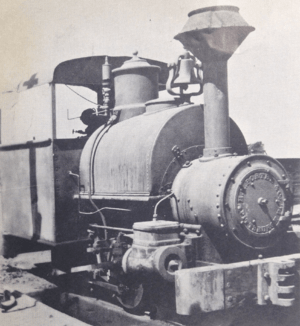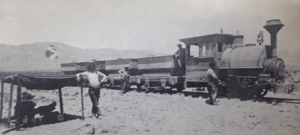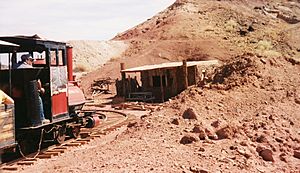Waterloo Mining Railroad facts for kids
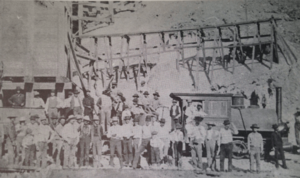
The Waterloo Mining Railroad was a special train line built to carry valuable silver ore. It was also known as the Calico Railroad or Daggett-Calico Railroad. This train line was a 3 ft (914 mm) narrow gauge railroad, meaning its tracks were closer together than regular train tracks. It was built to move silver from the mines in the Calico Mountains, near Calico, California, to processing plants near Daggett, California. The railroad operated from 1888 to 1903.
Later, the American Borax Company used part of this railroad for their borax mining. This happened around 1901. During this time, the line was sometimes called the American Borax Company Railroad (or A.B.C. Railroad) or the Columbia Mine Railroad. It continued to operate for about six more years.
Contents
History of the Calico Railroad
Silver Mining in Calico
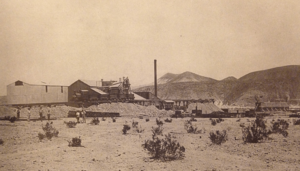
In the 1880s, Calico, California was a very busy and successful silver mining town in Southern California. It had about 1,200 people living there. Two main silver mines, the Waterloo and Silver King, produced over $1,000,000 worth of silver ore in just 14 months.
The Southern Pacific Railroad built a line to Daggett, California, which was about 10 miles (16 km) away. This helped them get involved in the silver business. In return, they supplied Calico with goods, wood, and other things the mines needed.
The Oro Grande Mining Company owned most of the silver mines in Calico. They were in charge of moving the silver ore from the mines to the Waterloo Mills near Daggett. They also handled shipping the finished silver products. Hauling silver ore cost about $2.50 per ton. However, they could only move so much ore at a time. Oro Grande used a team of 14 mules to haul the silver ore. They thought a short train line from Calico to Daggett would be much better.
In 1885, there were plans to build a standard-gauge train line. This line would connect Daggett to the silver mines and mills, and directly to Calico. But the Calico mines started producing less silver. Also, transportation costs went up, and silver prices went down. This made the train project too expensive, so the plans were stopped.
Building the Calico Railroad
By 1887, silver ore production at the mines had increased again. The Waterloo Mills at Daggett upgraded their operations. They could now process much more ore using electricity and water from the Mojave River. Because of this, it was decided that a railroad had to be built. This would help keep up with the demand for ore.
The Calico Railroad was built to be about 11 miles (18 km) long. It started at the Waterloo Mine, which was about 2 to 3 miles (3.2 to 4.8 km) west of Calico. From there, the line went straight down for about 11 miles (18 km). Then, it looped around Elephant Mountain, slowly going uphill. Finally, it reached the Waterloo Mill on the side of the mountain facing Daggett. A side track was later added to the Silver King Mine in Calico in 1889. The railroad went up Wall Street Canyon. At the end of the canyon, there was a huge bin where ore from the mine, high above the town, was dumped into the trains.
The train line never actually reached Daggett. But Daggett was right across the river from the mill at Elephant Mountain. So, if anything needed to be shipped to Daggett, wagons took the goods. People could also walk across the dry riverbed. The train line also carried a few passengers. However, it did not have special passenger cars. People rode in the ore wagons between Calico and Daggett. Miners also rode them from Calico to their workplaces.
The demand and prices for silver kept falling. This caused the Calico mines to decline. In March 1892, the Waterloo Mine closed. The Silver King Mine followed in 1896. The Calico Railroad stopped running for a while. The trains and wagons were stored near the Waterloo Mill. This was on the north-west side of the Mojave River, close to where the road bridge between Daggett and Yermo is today.
Later, in 1899, D.D. Connell and Marcus Pluth leased the Waterloo Mining Company's properties, including the railroad. They wanted to haul any profitable silver left in the mines. Silver ore was moved from the Waterloo Mine to Elephant Mountain. There, the silver was processed in the original mill that the company had built in 1883. This lease for silver operations lasted from 1899 until 1903.
Borax Mining Takes Over
In 1897, the Pacific Coast Borax Company started building the Borate and Daggett Railroad. This line would connect the nearby borax mines of Borate to the regular-sized railway at Daggett. They needed more trains to run their new line. So, they leased one of the Waterloo Mining Company's trains, No. 2, named "Emil." This train helped build the new line. "Emil" was said to slip on the steep hills going up to Borate. It was only used for a few months until the Pacific Coast Borax Company got its own train. Then, "Emil" was sent back to Waterloo.
The American Borax Company Railroad
In 1899, the American Borax Company bought mining claims at Lead Mountain. This was about four miles (6.4 km) west of Calico. They planned to mine boric acid there and build a railroad to Daggett. They had their processing plants across the river in Daggett.
The American Borax Company made an agreement with the Waterloo Mining Company and D.D. Connell. Connell was also leasing the line to transport the last of the silver ore. The agreement allowed American Borax trains to use the same tracks. These tracks went between the junctions towards Calico and the borax mine at Lead Mountain, which was called "Columbia." They also leased the railroad's first train, "Uncle Dan," to operate the borax trains from Lead Mountain.
The train line was extended from the mill branch at Elephant Mountain. It crossed the Mojave River on a special bridge. Then, it pulled into the Columbia Mill on the other side of the river. This is where the boric acid was processed into borax. Once the borax was ready, the train took it to the main train station in Daggett. There, the Atchison, Topeka & Santa Fe Railroad picked up the borax to sell it.
Both American Borax and D.D. Connell used the line for their own purposes. But in 1903, there was a bad train wreck between their two engines at a switch. This happened because Connell was rushing with his train, "Emil," to get back to Daggett during a storm. He wanted to end his lease. After the accident, Connell was hired to remove the train tracks towards Calico and all the wooden buildings in the town. The Waterloo Mining Co. then gave full ownership of the railroad to American Borax. They used the rest of the line for borax from the Columbia Mine at Lead Mountain.
By 1907, the American Borax Company found even better borax deposits. These were in the Tick Canyon Formation, about 30 miles (48 km) northwest of Los Angeles. They teamed up with another borax company, Sterling Borax, to claim these new deposits. Because of this, the mining operations at Daggett were shut down. All the mining equipment, even the railroad itself, was moved to Lang, California. This meant the mining operations in the Calico Mountains came to an end.
Trains and Wagons
The Waterloo Mining Railroad only had two trains. Both were built by H.K. Porter, Inc. in 1888. They were used on the train line between Daggett and Calico. One train was called 'Uncle Dan'. It was a small 0-4-0ST engine. The other was 'Emil', a slightly larger 0-6-0ST engine. Both trains were named after important people in the mining company and railroad. Daniel Wells Jr. and Emil Sanger were key figures. Emil Sanger became head of the Waterloo Mining Company in 1888 and ordered the railroad to be built.
Both trains were used on the line, even after the American Borax Company took over. In 1903, 'Emil' was bought by the Mohave and Milltown Railway. 'Uncle Dan' was left to handle the borax operations alone until about 1907. That's when the railroad was taken apart and moved to Lang, California. It was then used for mining at Tick Canyon by the Sterling Borax Company.
No records were kept about what happened to these two trains after that. It's a mystery whether they were sold, scrapped, or survived.
The railroad also had at least four ore wagons. These were built at the Virginia & Truckee Railroad's shops in Carson City, Nevada. There was also a water car. The American Borax Company added five more ore wagons for hauling borax. We don't know where these extra wagons came from.
What Remains Today
The town of Calico was bought and rebuilt in 1951 by Walter Knott. He owned Knott's Berry Farm. He turned Calico into a ghost town tourist attraction. A tourist railroad was planned to bring back the history of the old Waterloo Mining Railroad.
The 2 ft 6 in (762 mm) narrow gauge Calico and Odessa Railroad was built in 1954. It goes around one of the mountains near Calico Ghost Town. It passes an old silver mine shaft and the site of the former eastern part of Calico. This train line is operated by a single diesel engine that looks like a steam train.
The current tourist train line does not follow the exact path of the old Waterloo Mining Railroad. The original line started at the mouth of Wall Street Canyon. This area is now a paved road that tourists use to get to Calico from Interstate 10.
Some parts of the old train track bed can still be seen in the desert. However, much of it is now covered by new houses in Yermo. The best place to see traces of the old line is at the site of the former Waterloo Mine. There, a large ore bin used to dump silver ore into the trains below. You can also still see and explore the old foundations of the mills at Elephant Mountain near Daggett.


